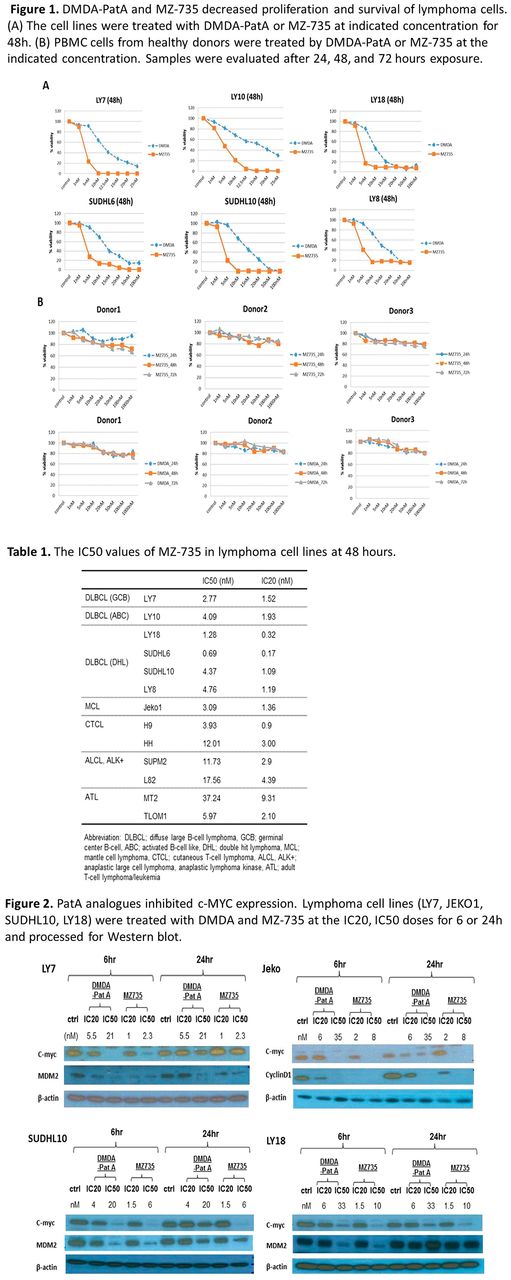Abstract
Introduction
The oncogene c-Myc is a master transcription factor that is associated with pathogenesis and chemo-resistance in a vast array of human cancers including aggressive lymphoma. Although the therapeutic benefit of targeting c-Myc has been demonstrated in many preclinical studies, direct inhibitors of c-Myc have not been successfully developed for the clinic. On the other hand, translation of c-Myc is highly dependent on the eukaryotic translation initiation factor 4F (eIF4F), a complex comprised of the eIF4A, eIF4G, and eIF4E subunits. These results suggest that silencing the translation of c-Myc via inhibiting eIF4F or its subunits may be a valid alternative strategy for indirectly targeting the "undruggable" c-Myc oncogene. In the current project, we have investigated the pharmacological activity and mechanism of Pateamine A (PatA) analogues in lymphoma cells in vitro . PatA was originally purified as a marine natural product and demonstrated anti-proliferation activity. One of the analogues, Biotin-DMDA-PatA conjugate (B-DMDA-PatA) pulled down eIF4A, specifically inhibits de novo protein synthesis with much less effect on de novo RNA synthesis, and specifically inhibits cap dependent translation. DMDA-PatA acts by decreasing the interaction between eIF4A and eIF4G. Our hypothesis is the following: If PatA analogues preferentially inhibit the translation of oncogenes such as c-Myc, then PatA analogues will be highly effective for c-Myc driven cancers and potentially safe for animals and humans.
Methods
MZ-735 is a recently developed and optimized PatA analogue, based on insights from DMDA-PatA. Both compounds were synthesized at the CPRIT Synthesis and Drug-Lead Discovery Laboratory at Baylor University. Cytotoxicity was evaluated in lymphoma cell lines using CellTiter-Glo (Promega®). The cells were exposed to the PatA analogues or the vehicle control on either continuous exposure or on a treatment (progressively decreasing exposure)-washout schedule. To evaluate the toxicity of PatA analogues to normal cells, cytotoxicity in peripheral blood mononuclear cells (PBMC) of healthy donors were tested. Immunoblot was used to study the molecular effects of MZ-735 on translation of oncogenes, particularly that of c-Myc, in lymphoma cell lines representing DLBCL, DHL, mantle cell lymphoma (MCL), cutaneous T cell lymphoma (CTCL), anaplastic large cell lymphoma (ALCL), and adult T cell lymphoma/leukemia (ATL). To further investigate the broad translational downregulation of poorly understood network of oncogenes by MZ-735, we are conducting in parallel proteomic and RNAseq studies in 3 cell lines representing DLBCL (no MYC translocation), DHL (with MYC and BCL2 translocation), and MCL (with CCND1 translocation). Finally, the efficacy and safety of MZ-735 will be investigated in xenograft mouse models of DHL.
Results
DMDA-PatA and MZ-735 were studied in 13 lymphoma cell lines. DMDA-PatA and MZ-735 exhibited concentration- and time-dependent cytotoxicity in lymphoma cell lines at low nanomolar concentrations (Figure 1A). The IC20 and IC50 values of each lymphoma cell lines are shown in Table 1. MZ-735 was more effective in B cell lymphoma than in T cell lymphoma cells. MZ-735 was significantly more potent than DMDA-PatA in all tested cell lines. Remarkably, a brief treatment by MZ-735 for as short as 3 hours followed by washout of the compound produced comparable cytotoxicity to that of continuous exposure of the compound without washout. Importantly, DMDA-PatA and MZ-735 did not show significant cytotoxic effect in PBMC from healthy donors (Figure 1B). MZ-735 markedly repressed the protein level of c-Myc in all tested lymphoma cell lines, and effectively suppressed the protein level of cyclin D1 in MCL cells (Figure 2). The expression of the MDM2 oncogene was suppressed in a way similar to C-MYC .
Conclusion
These results suggest that the PatA analogue MZ-735 has potent pharmacological activity in lymphoma cell lines, and acts by suppressing the production of critical oncogenes, including C-MYC, CCND1, and MDM2 , but is not toxic to normal PBMC. MZ-735 may cause rapid and irreversible modification of the translation apparatus, which is not affected by drug washout, leading to rapid commitment to growth arrest and death of cancer cells. MZ-735 is a promising and novel treatment for C-MYC- and CCND1 -driven aggressive lymphoma.
O'Connor: Trillium Therapeutics: Research Funding; Celgene: Honoraria, Research Funding.
Author notes
Asterisk with author names denotes non-ASH members.


This feature is available to Subscribers Only
Sign In or Create an Account Close Modal